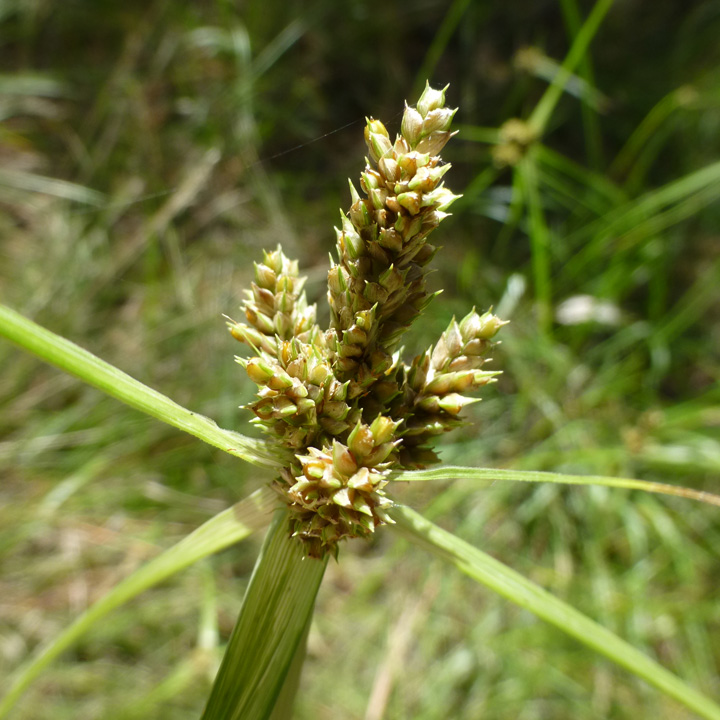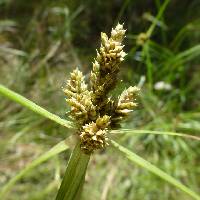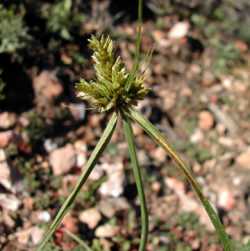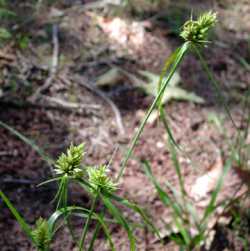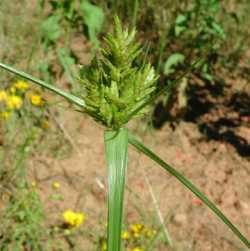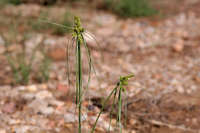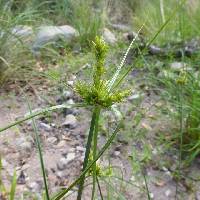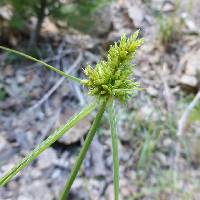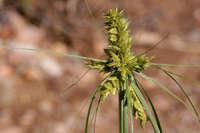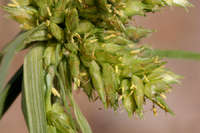Herbs, perennial, rhizomatous. Culms trigonous, (7-)20-70(-85) cm × (0.5-)1-1.8(-2.6) mm, glabrous or sparsely to densely scabridulous on surfaces or on angles immediately proximal to inflorescence in distal 3-6 cm. Leaves 2-3, flat to V-shaped, (12-)20-40(-55) cm × (2-)3-5(-7) mm. Inflorescences: spikes (1-)3-4(-6), largest erect, others at base of central spike, erect spike sessile, loosely to densely cylindric to ovoid-cylindric, (12-)18-30 × (6-)12-20 mm, remaining spikes 1/2 as large; rays absent; bracts (2-)3-6(-10), ± horizontal to reflexed parallel to culm, (2-)6-16(-25) cm × (1.5-)2-4(-7) mm; rachilla ± deciduous, wingless. Spikelets (8-)15-30, spreading to ascending-appressed, oblong-lanceoloid, quadrangular, slightly compressed, 5-8(-10) × (2-)2.4-3.4(-4.2) mm; floral scales (2-)4-6(-8), yellowish, reddish, or greenish brown, medially greenish, straight to excurved, laterally (2-)3-4(-5)-ribbed, medially (1-)3-(-5)-ribbed, ovate-orbiculate, 2.4-2.8(-3.4) × 2.4-2.8(-3.4) mm, apex obtuse, mucronate to cuspidate, stout, (0.1-)0.3-0.6 mm, medially glabrous. Flowers: anthers 0.4-0.8 mm; styles 0.7-1.3 mm; stigmas 0.7-1.2 mm. Achenes finely reticulate, brown to reddish brown, ± stipelike, obovoid, 1.6-1.9 × 1.1-1.4(-1.6) mm, base attenuate to cuneate, 0.1-0.2 × 0.2 mm, apex obtuse, apiculate, surfaces glabrous.
Fruiting summer. Clearings in montane forests; 500-1800 m; Ariz., Colo., N.Mex., Tex., Wyo.; Mexico.
Hybridization between Cyperus fendlerianus and C. sphaerolepis occurs occasionally in the southwestern United States and northern Mexico (B. G. Marcks 1972). The unnamed hybrid appears to be fully fertile and can be recognized by morphologic intermediacy.
Common Name: Fendler's flatsedge
Duration: Perennial
Nativity: Native
Lifeform: Graminoid
General: Rhizomatous perennial 20-70 cm, rhizomes 1-2 cm long, with ovate brown to reddish brown scales.
Vegetative: Culms 1-2 mm in diameter, glabrous or densely minutely roughened on surfaces; on angles adjacent to the inflorescence; leaves 2-3, flat to v-shaped, 20-40 cm long by 3-5 mm wide.
Inflorescence: Spike, 3-4 on each plant, largest erect, others at base of central spike, erect spike sessile, loosely to densely cylindric, 18-30 mm by 12-20 mm; rays absent, 3-6 bracts, rachilla deciduous, wingless, pale greenish white with successive scales 1.5-2 mm; spikelets 15-30, ovate-orbiculate, apically obtuse, mucronate apex, spreading to ascending-appressed, 5-8 mm by 2-3 mm; 4-6 floral scales, yellowish to reddish, greenish brown, laterally 3-4 ribbed, stout. Achenes 1.5-2 mm long, 1-1.5 mm wide, obovoid, obtuse apex, apiculate, brown to reddish brown.
Ecology: Found in clearings and along meadows in pine forests and juniper woodlands from 2,000-6,000 ft (610-1829 m); flowers July-September.
Notes: Distinguished by the horizontal to reflexed inflorescence bracts, the sessile, cylindric spikes, and the ovate-orbiculate, cuspidate scales. Known to hybridize with C. sphaerolepis, which can be distinguished by the intermediate morphology.
Ethnobotany: Seeds and stems used for fodder, the rhizomes were peeled and eaten, boiled or raw.
Etymology: Cyperus is from the Greek word meaning sedge, while fendlerianus is named for Augustus Fendler (1813-1883) a German plant collector.
Synonyms: Mariscus fendlerianus
Editor: SBuckley, 2010


